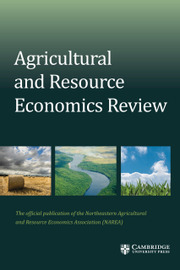Crossref Citations
This article has been cited by the following publications. This list is generated based on data provided by
Crossref.
Johansson, Robert C.
2002.
Watershed Nutrient Trading Under Asymmetric Information.
Agricultural and Resource Economics Review,
Vol. 31,
Issue. 2,
p.
221.
Shrestha, Ram K.
and
Loomis, John B.
2003.
Meta-Analytic Benefit Transfer of Outdoor Recreation Economic Values: Testing Out-of-Sample Convergent Validity.
Environmental and Resource Economics,
Vol. 25,
Issue. 1,
p.
79.
Colombo, S.
Calatrava-Requena, J.
and
Hanley, N.
2003.
The economic benefits of soil erosion control: An application of the contingent valuation method in the Alto Genil basin of southern Spain.
Journal of Soil and Water Conservation,
Vol. 58,
Issue. 6,
p.
367.
Sullivan, Patrick
Hellerstein, Daniel
Hansen, LeRoy
Johansson, Robert
Koenig, Steven
Lubowski, Ruben N.
McBride, William D.
McGranahan, David A.
Roberts, Michael J.
Vogel, Stephen J
and
Bucholz, Shawn
2004.
The Conservation Reserve Program: Economic Implications for Rural America.
SSRN Electronic Journal,
Swinton, Scott M.
Lupi, Frank
Robertson, G. Philip
and
Hamilton, Stephen K.
2007.
Ecosystem services and agriculture: Cultivating agricultural ecosystems for diverse benefits.
Ecological Economics,
Vol. 64,
Issue. 2,
p.
245.
Hansen, LeRoy
2007.
Conservation Reserve Program: Environmental Benefits Update.
Agricultural and Resource Economics Review,
Vol. 36,
Issue. 2,
p.
267.
Baylis, Kathy
Peplow, Stephen
Rausser, Gordon
and
Simon, Leo
2008.
Agri-environmental policies in the EU and United States: A comparison.
Ecological Economics,
Vol. 65,
Issue. 4,
p.
753.
Nickerson, Cynthia
Ribaudo, Marc
and
Higgins, Nathaniel Alan
2010.
The Farm Act's Regional Equity Provision: Impacts on Conservation Program Outcomes.
SSRN Electronic Journal,
Colombo, Sergio
and
Calatrava Requena, Javier
2011.
Análisis económico de la erosión del suelo: Valoración de los efectos externos en la cuenca del Alto Genil.
Economía Agraria y Recursos Naturales,
Vol. 4,
Issue. 8,
p.
21.
Almansa, C.
Calatrava, J.
and
Martínez-Paz, J.M.
2012.
Extending the framework of the economic evaluation of erosion control actions in Mediterranean basins.
Land Use Policy,
Vol. 29,
Issue. 2,
p.
294.
Knoche, Scott
and
Lupi, Frank
2013.
Economic benefits of publicly accessible land for ruffed grouse hunters.
The Journal of Wildlife Management,
Vol. 77,
Issue. 7,
p.
1294.
Bauer, Dana Marie
and
Johnston, Robert J.
2013.
The Economics of Rural and Agricultural Ecosystem Services: Purism versus Practicality.
Agricultural and Resource Economics Review,
Vol. 42,
Issue. 1,
p.
iii.
Leplat, Mélody
2014.
La congestion : une variable clé dans les modèles de choix de sites récréatifs.
Économie & prévision,
Vol. n° 200-201,
Issue. 2,
p.
185.
Knoche, Scott
Lupi, Frank
and
Suiter, Ashley
2015.
Harvesting benefits from habitat restoration: Influence of landscape position on economic benefits to pheasant hunters.
Ecological Economics,
Vol. 113,
Issue. ,
p.
97.
Fontaine, Joseph J.
Jorgensen, Christopher F.
Stuber, Erica F.
Gruber, Lutz F.
Bishop, Andrew A.
Lusk, Jeffrey J.
Zach, Eric S.
and
Decker, Karie L.
2017.
Species distributions models in wildlife planning: agricultural policy and wildlife management in the great plains.
Wildlife Society Bulletin,
Vol. 41,
Issue. 2,
p.
194.
Pang, Arwin
2017.
Incorporating the effect of successfully bagging big game into recreational hunting: An examination of deer, moose and elk hunting.
Journal of Forest Economics,
Vol. 28,
Issue. ,
p.
12.
Gigliotti, Larry M.
and
Sweikert, Lily A.
2019.
Wildlife value orientation of landowners from five states in the upper midwest, USA.
Human Dimensions of Wildlife,
Vol. 24,
Issue. 5,
p.
433.
Riley, Dylan
Mieno, Taro
Schoengold, Karina
and
Brozović, Nicholas
2019.
The impact of land cover on groundwater recharge in the High Plains: An application to the Conservation Reserve Program.
Science of The Total Environment,
Vol. 696,
Issue. ,
p.
133871.
Gascoigne, William
Hill, Rebecca
Haefele, Michelle
Loomis, John
and
Hyberg, Skip
2021.
Economics of the Conservation Reserve Program and the wildlife it supports: A case study of upland birds in South Dakota.
Journal of Outdoor Recreation and Tourism,
Vol. 35,
Issue. ,
p.
100385.
Lewis, Lynne
Raynor, Jennifer
and
Richardson, Leslie
2024.
The Nature of the Beast: Wildlife Valuation from the Iconic to the Ordinary.
Annual Review of Resource Economics
,
Vol. 16,
Issue. 1,
p.
167.

